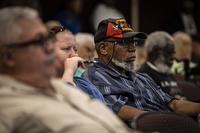Dear Sgt. Shaft:
I would appreciate it if you would answer a question for me. My wife is deceased, and I am wondering how long it will take for my new wife, if I remarry, to come under TRICARE For Life. (TRICARE is the health care program serving uniformed service members, retirees and their families worldwide.)
John R.
Via the Internet
Dear John:
My sources tell me that TRICARE For Life benefits start immediately after the new spouse is registered in Defense Enrollment Eligibility Reporting System (DEERS) while you get her a new military ID card at your nearest ID card office. You should bring your marriage certificate and two forms of ID for each of you.
Shaft notes
• Congressman Gus M. Bilirakis, Florida Republican, will host his Seventh Annual Veterans’ Resource Fair on Saturday, June 29, from 11 a.m. to 2 p.m at River Ridge High School in New Port Richey, Fla.
The event is a one-stop shop for Florida’s 1.5 million veterans, bringing together 75 veterans organizations to help them navigate and take advantage of the various services they’ve earned as members of our Armed Forces.
“As vice-chairman of the Veterans’ Affairs Committee and co-chairman of the Military Veterans Caucus, I am working to ensure our veterans receive the benefits, care and opportunity they’ve earned,” Mr. Bilirakis said. “This event is just one way to show our appreciation for those who have defended and protected our freedoms.”
At the event, veterans can take advantage of medical and dental care, claims and education benefits assistance, job placement and employment services, and housing and social services. There will also be a special musical performance by Tony Orlando (“Tie a Yellow Ribbon Round the Ole Oak Tree”) and a presentation of the colors by AVAST, the nation’s only all-amputee color guard.
For more information, contact Mr. Bilirakis’ office at 813/501-4942 or visit www.bilirakis.house.gov.
• The U.S. Department of Defense recently announced that the California National Guard will be receiving $1 million for the Work for Warriors Program (WFW), which aims to reduce unemployment in the California National Guard by 25 percent.
Established in 2012, the Work for Warriors Program directly places unemployed California National Guard members into jobs by using business contacts from the WFW Business Coordinator and provides details on job openings. WFW staff also identify unemployed CNG candidates that meet specific job requirements and guides the unemployed CNG members through the entire hiring process, including resume preparation, interview and employment acceptance.
In March, Rep. Mark Takano (ranking member — Economic Opportunity Subcommittee) questioned Major Ty Shepard from the California Military Department during a Veterans’ Affairs Economic Opportunity Subcommittee meeting about the Work for Warriors program funding needs:
Mr. Takano: “Would your program, the ‘Work for Warriors’ program, be more effective with additional funding?”
Major Shepard: “Definitely. Right now, our case managers, that are handing our applicants, are handling between 500 to 700 service members. […] If we reduce that number down to 200 to 250, maybe even less than that, we would be much more efficient, as far as placing folks and getting people into jobs.”
After the announcement, Mr. Takano, California Democrat, said, “For the last year, the Work for Warriors program has proven to be incredibly effective in putting members of the California National Guard back to work. I’m pleased to see the Department of Defense recognize its efficacy and provide additional funding so these committed public servants can continue to support their families and contribute to their communities.”
Major Gen. David Baldwin, The Adjutant General of the California Military Department, said: “It’s with deep gratitude that I thank Congressman Mark Takano for taking up an issue that is too often ignored — unemployment among the members of our Armed Forces.
“Because of the congressman’s vigilant leadership, the California Military Department will receive $1 million in federal funds to continue leading the effort to lower the unemployment rate across the California National Guard, all of which will go directly to the Work for Warriors employment program. At present, our limited funding efforts only allow us to place two to three out-of-work Guardsmen each day; this funding will go to hiring desperately needed employment officers across the state and help us to improve those numbers dramatically.”
• Approximately 9,000 homeless veterans living on the streets and in the nation’s shelter system will soon find a permanent place to call home.
U.S. Housing and Urban Development (HUD) Secretary Shaun Donovan and U.S. Department of Veterans Affairs (VA) Secretary Eric K. Shinseki announced recently that HUD will provide $60 million to local public housing agencies across the country to offer permanent supportive housing to homeless veterans, many of whom are living with chronic disabling conditions.
The supportive housing assistance is provided through the HUD-Veterans Affairs Supportive Housing (HUD-VASH) Program which combines rental assistance from HUD with case management and clinical services provided by VA. Since 2008, a total of 48,385 vouchers have been awarded and 42,557 formerly homeless Veterans are currently in homes because of HUD-VASH.
“These HUD-VASH vouchers are a critical resource to accomplish our shared goal of ending Veterans’ homelessness in 2015,” Mr. Shinseki said. “With the continued support of President Obama, Congress and our community partners, we will end homelessness among veterans and provide these brave men and women with the earned care and benefits that help them live productive, meaningful lives.”
HUD-VASH is a critical part of the Obama Administration’s commitment to end veteran and long-term chronic homelessness in 2015. “Opening Doors: Federal Strategic Plan to Prevent and End Homelessness” serves as a map for how the federal government will work with state and local communities to confront the root causes of homelessness, especially among former servicemen and women.
HUD’s annual “point in time” estimate of the number of homeless persons and families for 2012 found that veteran homelessness fell by 7.2 percent (or 4,876 people) since January 2011 and by 17.2 percent since January 2009. On a single night in January 2012, 62,619 veterans were homeless.
• Send letters to Sgt. Shaft, c/o John Fales, P.O. Box 65900, Washington, D.C. 20035-5900; fax 301/622-3330, call 202/257-5446 or email sgtshaft@bavf.org.










